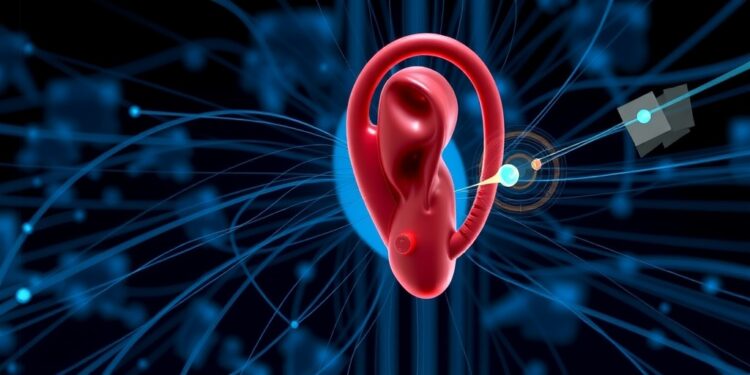
Conductive hearing loss is a prevalent issue that affects many individuals, particularly children, where sounds fail to reach the inner ear due to blockages or structural problems within the outer or middle ear. Conventional treatments for this condition have often included invasive surgeries and the fitting of implantable hearing devices, which can present significant risks, especially in young patients. However, innovative advancements in bioengineering and acoustic technology are ushering in a new era of non-invasive treatment methods aimed to enhance auditory experiences without the risks associated with surgery.
A pioneering study conducted by a dedicated team at Wake Forest University School of Medicine introduces a groundbreaking hearing aid based on flexible micro-epidermal actuators. This innovative device harnesses vibration technology to transmit sound waves directly to the cochlea, the vital component of the inner ear responsible for auditory processing. Unlike traditional hearing aids, which may amplify sounds and direct them through the ear canal, this new design bypasses the anatomical structures that may hinder sound transmission, offering a fresh perspective on treatment options for conductive hearing loss.
The researchers, spearheaded by Dr. Mohammad J. Moghimi, an assistant professor of biomedical engineering, emphasize the importance of a multifaceted approach to developing hearing aids that cater to diverse patient needs. Employing micro-epidermal actuators, their device generates vibrations against the skin behind the ear, allowing sound to travel efficiently to the inner ear. This non-invasive model aims to improve the accessibility and effectiveness of hearing solutions for children, who often face developmental delays related to untreated hearing issues.
Participants in this study included ten individuals aged between 19 and 39, who were equipped with earplugs and earmuffs to simulate conditions of conductive hearing loss. As the researchers tested various configurations of the actuator arrays, they discovered that using multiple actuators simultaneously led to significant enhancements in the vibrational strength and audio quality. Such findings reveal the potential of this technology to deliver a richer and more nuanced auditory experience, enhancing clarity across a range of sound frequencies.
The implications of this research extend beyond mere auditory enhancement; they hold the potential for profound impacts on speech and language development. Children with hearing impairments often face challenges in communication skills, which can hinder their educational progress and social interactions. The innovative hearing aid designed by Dr. Moghimi’s team could be pivotal in bridging these gaps, allowing children to engage with their surroundings more fully and interact with peers more effectively.
Importantly, the study opens up new avenues of research into the physiological responses and bioacoustic properties of the human ear. By understanding how vibrations can be manipulated externally to elicit a positive auditory response, scientists can begin to chart pathways for further advancements in acoustic devices. This research not only fuels momentum in the field of audiology but also encourages collaboration among biomedical engineers, audiologists, and healthcare professionals.
As the team prepares for further trials aimed at evaluating the safety and efficacy of their innovative hearing aid in broader populations, the focus will remain on pediatric subjects, who could reap the most benefits. The implications of such technology for young patients are critical, as early intervention can drastically improve their quality of life and overall development. Conductive hearing loss treatment that prioritizes comfort and accessibility is a vital step toward optimizing health outcomes for children.
In parallel, the study highlights the broader implications for healthcare systems that grapple with the challenges of treating hearing loss. By addressing the needs of children and the unique vulnerabilities they face, healthcare providers can implement more effective strategies that combine modern technology with empathetic care. The integration of advanced hearing aids into clinical practice opens a plethora of opportunities to enhance patient care and foster holistic development.
Furthermore, the international patent application filed by Dr. Moghimi for the flexible hearing aid underscores the commercial potential of such innovative technologies. Should this device receive successful validation in upcoming studies, it could usher in a new wave of audiological solutions on the market, providing families and healthcare providers with a fresh set of tools to combat conductive hearing loss more effectively.
Ultimately, this research illuminates the transformative possibilities that arise when innovation intersects with compassion for patients. It reminds us of the essential role that engineering and technology can play in the realm of health, particularly in making critical healthcare solutions accessible to the individuals who need them most. As developments continue to unfold in this field, the work of Dr. Moghimi and his team embodies a commitment to reshape the future of hearing aid technology and redefine hope for those affected by hearing impairments.
With a promising next phase on the horizon, where rigorous testing can ensure both effectiveness and safety for a wider audience, we stand at the brink of potentially redefining the landscape of hearing aids as we know them. The advances made by researchers at Wake Forest University could ensure that children with conductive hearing loss receive the auditory support necessary not merely to hear, but to thrive in every aspect of their lives. This venture represents a milestone in both medical science and compassion-driven innovation.
In summary, the research team’s design is a testament to the power of interdisciplinary collaboration in addressing complex health issues. By integrating engineering principles with bioacoustic science and audibility needs, their innovative approach presents a significant leap forward in the realm of hearing aids. The possibilities that lie ahead for pediatric patients are not just exciting; they remind us of the profound impacts that thoughtful research and development can produce in our society.
Subject of Research:
Article Title:
News Publication Date:
Web References:
References:
Image Credits:
Keywords
Tags: acoustic technology innovationsauditory processing and cochlea functionbioengineering advancements in hearing aidsconductive hearing loss treatmentflexible micro-epidermal actuatorsnon-surgical hearing aid optionsnoninvasive hearing aid technologypediatric hearing loss solutionsrevolutionary hearing device designrisks of invasive hearing treatmentssound transmission to cochleaWake Forest University School of Medicine study





